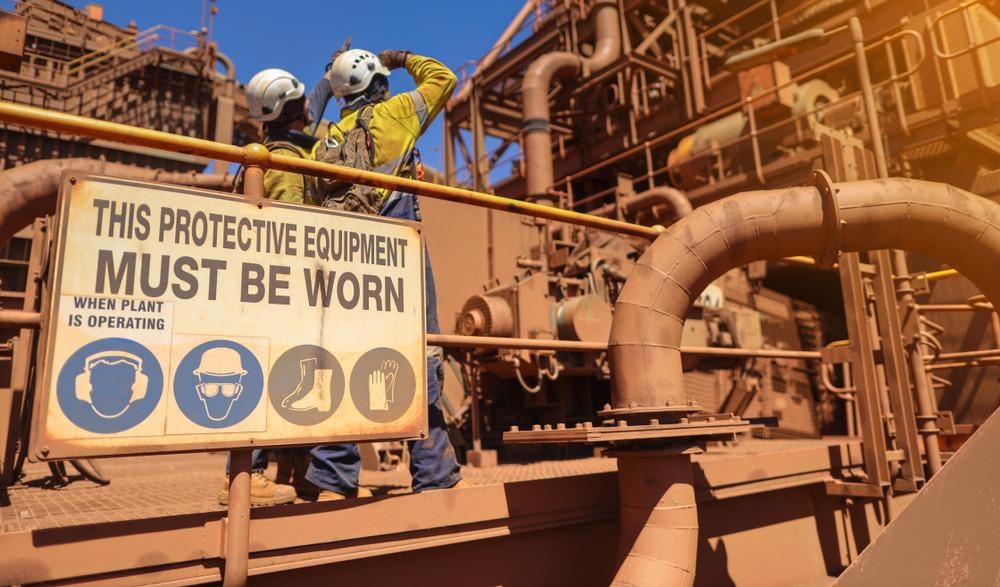Often involving harsh conditions and work with heavy machinery, mining is one of the most dangerous modern industries, and while safety has been a major focus for as long as mines have been around, the use of cutting-edge artificial intelligence and machine learning technologies are opening a new realm of possibility.

Image Credit: King Ropes Access/Shutterstock.com
More specifically, cutting-edge predictive safety systems are being developed to anticipate accident rates based on a set of working conditions. Machine learning algorithms trained on safety data accurately predict injury statistics. These systems are still in their infancy, but mine operators are becoming increasingly invested in the technology.
The adoption of machine learning and automation in mining would likely not be where it is today without the COVID-19 pandemic. The crisis acted as an accelerant for the adoption of technology that takes humans out of the equation. Mining companies used the technology to remove many workers from potentially hazardous situations and the success they saw validated the use of remote operations. Meanwhile, many companies that did not adopt these technologies fell behind the rest of the pack.
The Current Focus of Research in Integrated Predictive Safety Systems
The capability to collect data that can power sophisticated analytics is facilitating a shift; from a generalized analysis of historical safety data to solutions based on predictive models.
With the appropriate data, analytics can help mining operators recognize specific scenarios related to a greater risk of injury and relevant solutions. Results from the latest research are showing a high level of accuracy from machine learning models.
In a September 2020 study, researchers used models trained on historical datasets to predict the number of days away from work caused by accidents.
Interestingly, the study team revealed that detailed accident narratives fed into the models led to better predictions than models trained on context-free tabular data. The study team said superior narratives-based predictions were likely due to additional details provided by the person recording the incident.
For instance, an accident narrative might explain how a worker was injured when a tiny bit of metal flew under their safety shield and safety glasses. Tabular data on such an incident typically would not make any mention of the worker wearing a safety shield or safety glasses.
In other results of the study, maintenance workers were found to have the highest risk of injury of all types of workers at open-pit mines.
Researchers also found that total mining experience played a significant role when it came to the risk of severe injury. However, the job-related experience was not found to have a significant relationship to the severity of the injury.
Shift start time and time of day were also found to be major factors related to injury severity. Furthermore, material handling was found to be the activity most associated with significant injury among mining workers.
The study team said the results show the potential benefits of machine learning when it comes to predictive safety. With their ability to handle large amounts of multidimensional data and improve over time, machine learning models will be invaluable when it comes to making better decisions around mining safety.
The Future of Predictive Safety Systems in the Mining Sector
One of the biggest hurdles for predictive safety systems is the capacity to collect optimal data. Unfortunately, simply gathering massive amounts of tabular data is not enough to provide useful insights. Furthermore, current mining technologies exist in separate silos, making data gathering difficult.
Accelerated by COVID-19, mining operations are shifting to a more centralized model and this shift will be beneficial when it comes to aggregating useful data. This centralization will help to break down silos and unify data sources. As this happens, it will be important to sustain available, consistent, and reliable data.
Standards must be kept high by executives who oversee the collection and processing of data. Furthermore, internal data may not be enough to generate significant insights, and executives who oversee data may have to coordinate with their counterparts across the industry.
The emergence of wearable technology offers significant promise when it comes to enhancing the safety of mining operations and integrated predictive safety. However, the many different wearable devices out there exist in silos. Safety-relevant data collected from watches, hard hats and other wearables has limited value if it cannot be unified.
Computer vision, video analysis, and collision prevention systems on vehicles are other areas that hold significant promise for integrated predictive safety systems. Data collected from these systems could be used in areas such as preventative maintenance and malfunction prediction.
Furthermore, the continued rollout of automated and robotics assets will not only fuel predictive safety measures through data collection, but also offer the bonus of taking humans out of harm's way.
Once again, the data provided by all these emerging technologies will have limited use for predictive safety if there is a significant lack of integration. In addition to developing these technologies, there also needs to be significant effort put towards integrating the various pieces of this complex jigsaw puzzle.
References and Further Reading
Prinsloo, G. et al. Trend 9: On the road to zero harm. Deloitte Insights. [Online] Available at: https://www2.deloitte.com/us/en/insights/industry/mining-and-metals/tracking-the-trends/2021/next-generation-mining-safety-technology.html
Carr, J. AI predictive maintenance is the holy grail for mining. Axora. [Online] Available at: https://www.axora.com/insights/ai-predictive-maintenance-holy-grail-mining/
Yedla, A. et al. (2020) Predictive Modeling for Occupational Safety Outcomes and Days Away from Work Analysis in Mining Operations. International Journal of Environmental Research and Public Health. 17(19):7054 http://dx.doi.org/10.3390/ijerph17197054
Deloitte. Workplace Safety Analytics. [Online] Available at: https://www2.deloitte.com/content/dam/Deloitte/ca/Documents/Analytics/ca-en-analytics-workplace-safety-analytics.pdf
Disclaimer: The views expressed here are those of the author expressed in their private capacity and do not necessarily represent the views of AZoM.com Limited T/A AZoNetwork the owner and operator of this website. This disclaimer forms part of the Terms and conditions of use of this website.